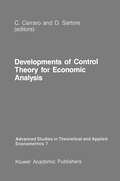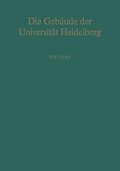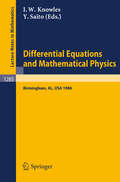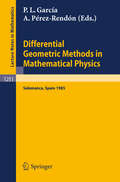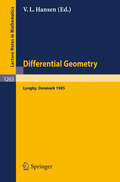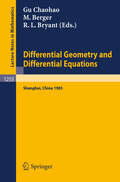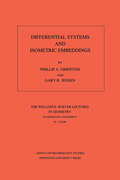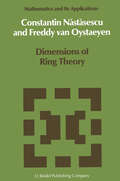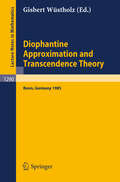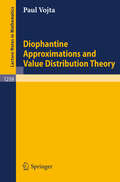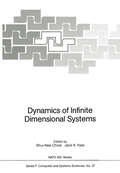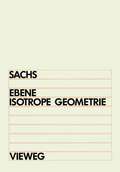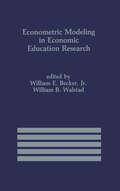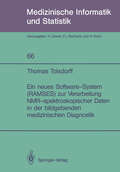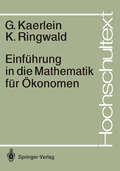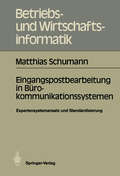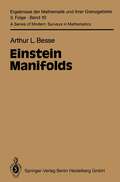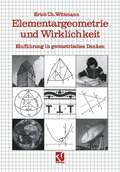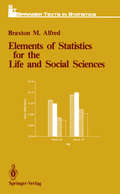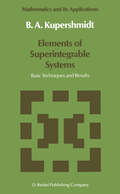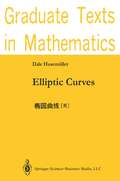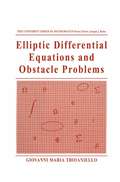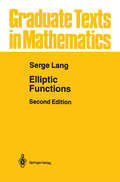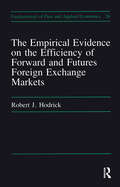- Table View
- List View
Developments of Control Theory for Economic Analysis (Advanced Studies in Theoretical and Applied Econometrics #7)
by Carlo Carraro D. SartoreGiovanni Castellani Rector of the University of Venice This book contains the Proceedings of the Conference on "Economic Policy and Control Theory" which was held at the University of Venice (Italy) on 27 January-l February 1985. The goal of the Conference was to survey the main developments of control theory in economics, by emphasizing particularly new achievements in the analysis of dynamic economic models by con trol methods. The development of control theory is strictly related to the development of science and technology in the last forty years. Control theory was indeed applied mainly in engineering, and only in the sixties economists started using control methods for analys ing economic problems, even if some preliminary economic applica tions of calculus of variations, from which control theory was then developed, date back to the twenties. Applications of control theory in economics also had to solve new, complicated, problems, like those encountered in optimal growth models, or like the determination of the appropriate inter temporal social welfare function, of the policy horizon and the relative final state of the system, of the appropriate discount factor. Furthermore, the uncertainty characterizing economic models had to be taken into account, thus giving rise to the development of stochastic control theory in economics.
Die Gebäude der Universität Heidelberg: Textband
by B. Auer Ingeborg Klinger D. Griesbach K. Güthlein A. Krämer M. Maisant C. PrestelDifferential Equations and Mathematical Physics: Proceedings of an International Conference held in Birmingham, Alabama, USA, March 3-8, 1986 (Lecture Notes in Mathematics #1285)
by Ian W. Knowles Yoshimi SaitoThe meeting in Birmingham, Alabama, provided a forum for the discussion of recent developments in the theory of ordinary and partial differential equations, both linear and non-linear, with particular reference to work relating to the equations of mathematical physics. The meeting was attended by about 250 mathematicians from 22 countries. The papers in this volume all involve new research material, with at least outline proofs; some papers also contain survey material. Topics covered include: Schrödinger theory, scattering and inverse scattering, fluid mechanics (including conservative systems and inertial manifold theory attractors), elasticity, non-linear waves, and feedback control theory.
Differential Geometric Methods in Mathematical Physics: Proceedings of the 14th International Conference held in Salamanca, Spain, June 24 - 29, 1985 (Lecture Notes in Mathematics #1251)
by Pedro L. Garcia Antonio Perez-RendonThe focal topic of the 14th International Conference on Differential Geometric Methods was that of mathematical problems in classical field theory and the emphasis of the resulting proceedings volume is on superfield theory and related topics, and classical and quantized fields.
Differential Geometry: Proceedings of the Nordic Summer School held in Lyngby, Denmark, Jul. 29-Aug. 9, 1985 (Lecture Notes in Mathematics #1263)
by Vagn Lundsgaard HansenThe Nordic Summer School 1985 presented to young researchers the mathematical aspects of the ongoing research stemming from the study of field theories in physics and the differential geometry of fibre bundles in mathematics. The volume includes papers, often with original lines of attack, on twistor methods for harmonic maps, the differential geometric aspects of Yang-Mills theory, complex differential geometry, metric differential geometry and partial differential equations in differential geometry. Most of the papers are of lasting value and provide a good introduction to their subject.
Differential Geometry and Differential Equations: Proceedings of a Symposium, held in Shanghai, June 21 - July 6, 1985 (Lecture Notes in Mathematics #1255)
by Chaohao Gu Marcel Berger Robert L. BryantThe DD6 Symposium was, like its predecessors DD1 to DD5 both a research symposium and a summer seminar and concentrated on differential geometry. This volume contains a selection of the invited papers and some additional contributions. They cover recent advances and principal trends in current research in differential geometry.
Differential Systems and Isometric Embeddings.(AM-114), Volume 114 (PDF)
by Phillip A. Griffiths Gary R. JensenThe theory of exterior differential systems provides a framework for systematically addressing the typically non-linear, and frequently overdetermined, partial differential equations that arise in differential geometry. Adaptation of the techniques of microlocalization to differential systems have led to recent activity on the foundations of the theory; in particular, the fundamental role of the characteristic variety in geometric problems is now clearly established. In this book the general theory is explained in a relatively quick and concrete manner, and then this general theory is applied to the recent developments in the classical problem of isometric embeddings of Riemannian manifolds.
Dimensions of Ring Theory (Mathematics and Its Applications #36)
by C. Nastasescu Freddy Van OystaeyenApproach your problems from the right end It isn't that they can't see the solution. It is and begin with the answers. Then one day, that they can't see the problem. perhaps you will find the final question. G. K. Chesterton. The Scandal of Father 'The Hermit Gad in Crane Feathers' in R. Brown 'The point of a Pin'. van Gulik's The Chinese Maze Murders. Growing specialization and diversification have brought a host of monographs and textbooks on increasingly specialized topics. However, the "tree" of knowledge of mathematics and related fields does not grow only by putting forth new branches. It also happens, quite often in fact, that branches which were thought to be completely disparate are suddenly seen to be related. Further, the kind and level of s9phistication of mathematics applied in various sciences has changed drastically in recent years: measure theory is used (non trivially) in regional and theoretical economics; algebraic geometry interacts with physics; the Minkowsky lemma, coding theory and the structure of water meet one another in packing and covering theory; quantum fields, crystal defects and mathematical programming profit from homotopy theory; Lie algebras are relevant to filtering; and prediction and electrical engineering can use Stein spaces. And in addition to this there are such new emerging subdisciplines as "experimental mathematics", "CFD", "completely integrable systems", "chaos, synergetics and large-scale order", which are almost impossible to fit into the existing classification schemes. They draw upon widely different sections of mathematics.
Diophantine Approximation and Transcendence Theory: Seminar, Bonn (FRG) May - June 1985 (Lecture Notes in Mathematics #1290)
by Gisbert WüstholzDiophantine Approximations and Value Distribution Theory (Lecture Notes in Mathematics #1239)
by Paul Alan VojtaDynamics of Infinite Dimensional Systems (NATO ASI Subseries F: #37)
by Shui-Nee Chow Jack K. HaleThe 1986 NATO Advanced Study Insti tute on Dynamics of Infini te Dimensional Systems was held at the Instituto Superior Tecnico. Lisbon. Portugal. In recent years. there have been several research workers who have been considering partial differential equations and functional differential equations as dynamical systems on function spaces. Such approaches have led to the formulation of more theoretical problems that need to be investigated. In the applications. the theoretical ideas have contributed significantly to a better understanding of phenomena that have been experimentally and computationally observed. The investigators of this development come wi th several different backgrounds - some from classical partial differential equations. some from classical ordinary differential equations and some interested in specific applications. Each group has special ideas and often these ideas have not been transmitted from one group to another. The purpose of this NATO Workshop was to bring together research workers from these various areas. It provided asoundboard for the impact of the ideas of each respective discipline. We believe that goal was accomplished. but time will be a better judge. We have included the list of participants at the workshop. with most of these giving a presentation. Although the proceedings do not include all of the presentations. it is a good representative sampie. We wish to express our gratitude to NATO. and.to Dr. M. di Lullo of NATO. who unfortunately did not live to see the completion of this project.
Econometric Modeling in Economic Education Research (International Series in Economic Modelling #2)
by William E. Becker Jr. Rolf A. WalstadSince its establishment in the 1950s the American Economic Association's Committee on Economic Education has sought to promote improved instruction in economics and to facilitate this objective by stimulating research on the teaching of economics. These efforts are most apparent in the sessions on economic education that the Committee organizes at the Association's annual meetings. At these sessions economists interested in economic education have opportunities to present new ideas on teaching and research and also to report the findings of their research. The record of this activity can be found in the Proceedings of the American Eco nomic Review. The Committee on Economic Education and its members have been actively involved in a variety of other projects. In the early 1960s it organized the National Task Force on Economic Education that spurred the development of economics teaching at the precollege level. This in turn led to the development of a standardized research instrument, a high school test of economic understanding. This was followed later in the 1960s by the preparation of a similar test of understanding college economics. The development of these two instruments greatly facilitated research on the impact of economics instruction, opened the way for application of increasingly sophisticated statistical methods in measuring the impact of economic education, and initiated a steady stream of research papers on a subject that previously had not been explored.
Ein neues Software-System (Medizinische Informatik, Biometrie und Epidemiologie #66)
by Thomas TolxdorffEinführung in die Mathematik für Ökonomen (Hochschultext)
by Gerd Kaerlein Karl RingwaldDieses Buch ist aus Veranstaltungen der Autoren an der Universität-GH Duisburg entstanden. Neben der Einführung und den Grundlagen enthält das Buch die Gebiete "Lineare Algebra" und "Analysis", es enthält somit ungefähr den Stoff einer zweisemestrigen zweistündigen Vorlesung und soll das für wirtschaftswissenschaftliche Anwendungen wichtigste mathematische Instrumentarium auf einem anschaulichen Niveau vermitteln. Das Buch wendet sich vor allem an Studenten mit geringen mathematischen Vorkenntnissen. Es möchte helfen, die bei vielen Studenten der Wirtschaftswissenschaften vorhandene Abneigung gegen formale Methoden abzubauen. Zu diesem Zweck werden, soweit dies in einem Lehrtext dieses Umfanges möglich ist, die mathematischen Probleme und Verfahren anhand wirtschaftswissenschaftlicher Fragestellungen entwickelt oder mit deren Hilfe illustriert. Das Buch verzichtet weitgehend auf formale Beweisführungen und gibt anhand von Beispielen Plausibilitätsüberlegungen für Definitionen und Aussagen.
Eingangspostbearbeitung in Bürokommunikationssystemen: Expertensystemansatz und Standardisierung (Betriebs- und Wirtschaftsinformatik #19)
by Matthias SchumannEinstein Manifolds (Classics In Mathematics Ser.)
by Arthur L. BesseEinstein's equations stem from General Relativity. In the context of Riemannian manifolds, an independent mathematical theory has developed around them. This is the first book which presents an overview of several striking results ensuing from the examination of Einstein’s equations in the context of Riemannian manifolds. Parts of the text can be used as an introduction to modern Riemannian geometry through topics like homogeneous spaces, submersions, or Riemannian functionals.
Elements of Statistics for the Life and Social Sciences (Springer Texts in Statistics)
by Braxton M. AlfredThis book was written to myself at about the time I began graduate studies in anthropology-the sort of thing a Samuel Beckett character might do. It is about the conduct of research. In a very real sense the purpose is partially to compensate for the inadequacies of my professors. Perhaps this is what education is about. The effort has not been an unqualified success, but it has been extremely gratifying. I was trained in anthropology. After completing the Ph. D. I went to Stanford on a post-doctoral fellowship. At the time, this was a novelty and the depart ment was not prepared for such a thing. To stay occupied I began attending lectures, seminars, and discussion groups in mathematics and statistics. This was about the luckiest choice I ever made. The excitement was easily as intense as that which I experienced upon encountering anthropology. On one oc casion I innocently and independently proved a theorem that had first been done 2000 years earlier. It is currently used as an exercise in high school mathematics so it is neither difficult nor arcane. Learning all this did not tarnish my sense of discovery. (On reflection I am puzzled by my failure to have seen all this "beauty" when I was exposed to it as an undergraduate. The unparalleled excellence of the Stanford program was undoubtedly responsible for my belated conversion.
Elements of Superintegrable Systems: Basic Techniques and Results (Mathematics and Its Applications #34)
by B. KupershmidtApproach your problems from the right end It isn't that they can't see the solution. It is and begin with the answers. Then one day. that they can't see the problem. perhaps you will find the final question. G. K. Chesterton. The Scandal of Father 'The Hennit Clad in Crane Feathers' in R. Brown 'The point of a Pin'. van Gulik's The Chinese Maze Murders. Growing specialization and diversification have brought a host of monographs and textbooks on increasingly specialized topics. However, the "tree" of knowledge of mathematics and related fields does not grow only by putting forth new branches. It also happens, quite often in fact, that branches which were thought to be completely disparate are suddenly seen to be related. Further, the kind and level of sophistication of mathematics applied in various sciences has changed drastically in recent years: measure theory is used (non-trivially) in regional and theoretical economics; algebraic geometry interacts with physics; the Minkowsky lemma, coding theory and the structure of water meet one another in packing and covering theory; quantum fields, crystal defects and mathematical programming profit from homotopy theory; Lie algebras are relevant to filtering; and prediction and electrical engineering can use Stein spaces. And in addition to this there are such new emerging subdisciplines as "experimental mathematics", "CFD", "completely integrable systems", "chaos, synergetics and large-scale order", which are almost impossible to fit into the existing classification schemes. They draw upon widely different sections of mathematics.
Elliptic Curves (Graduate Texts in Mathematics #111)
by Dale HusemollerThe book divides naturally into several parts according to the level of the material, the background required of the reader, and the style of presentation with respect to details of proofs. For example, the first part, to Chapter 6, is undergraduate in level, the second part requires a background in Galois theory and the third some complex analysis, while the last parts, from Chapter 12 on, are mostly at graduate level. A general outline ofmuch ofthe material can be found in Tate's colloquium lectures reproduced as an article in Inven tiones [1974]. The first part grew out of Tate's 1961 Haverford Philips Lectures as an attempt to write something for publication c10sely related to the original Tate notes which were more or less taken from the tape recording of the lectures themselves. This inc1udes parts of the Introduction and the first six chapters The aim ofthis part is to prove, by elementary methods, the Mordell theorem on the finite generation of the rational points on elliptic curves defined over the rational numbers. In 1970 Tate teturned to Haverford to give again, in revised form, the originallectures of 1961 and to extend the material so that it would be suitable for publication. This led to a broader plan forthe book.
Elliptic Differential Equations and Obstacle Problems (University Series in Mathematics)
by Giovanni Maria TroianielloIn the few years since their appearance in the mid-sixties, variational inequalities have developed to such an extent and so thoroughly that they may now be considered an "institutional" development of the theory of differential equations (with appreciable feedback as will be shown). This book was written in the light of these considerations both in regard to the choice of topics and to their treatment. In short, roughly speaking my intention was to write a book on second-order elliptic operators, with the first half of the book, as might be expected, dedicated to function spaces and to linear theory whereas the second, nonlinear half would deal with variational inequalities and non variational obstacle problems, rather than, for example, with quasilinear or fully nonlinear equations (with a few exceptions to which I shall return later). This approach has led me to omit any mention of "physical" motivations in the wide sense of the term, in spite of their historical and continuing importance in the development of variational inequalities. I here addressed myself to a potential reader more or less aware of the significant role of variational inequalities in numerous fields of applied mathematics who could use an analytic presentation of the fundamental theory, which would be as general and self-contained as possible.
Elliptic Functions (Graduate Texts in Mathematics #112)
by Serge LangElliptic functions parametrize elliptic curves, and the intermingling of the analytic and algebraic-arithmetic theory has been at the center of mathematics since the early part of the nineteenth century. The book is divided into four parts. In the first, Lang presents the general analytic theory starting from scratch. Most of this can be read by a student with a basic knowledge of complex analysis. The next part treats complex multiplication, including a discussion of Deuring's theory of l-adic and p-adic representations, and elliptic curves with singular invariants. Part three covers curves with non-integral invariants, and applies the Tate parametrization to give Serre's results on division points. The last part covers theta functions and the Kronecker Limit Formula. Also included is an appendix by Tate on algebraic formulas in arbitrary charactistic.
Empirical Evidence on the Efficiency of Forward and Futures Foreign Exchange Markets (Fundamentals Of Pure And Applied Economics Ser.)
by Robert J. HodrickThis book presents a critical review of the empirical literature that studies the efficiency of the forward and futures markets for foreign exchange. It provides a useful foundation for research in developing quantitative measures of risk and expected return in international finance.
Empirical Evidence on the Efficiency of Forward and Futures Foreign Exchange Markets (Fundamentals Of Pure And Applied Economics Ser.)
by Robert J. HodrickThis book presents a critical review of the empirical literature that studies the efficiency of the forward and futures markets for foreign exchange. It provides a useful foundation for research in developing quantitative measures of risk and expected return in international finance.
